|
|
|
Sort Order |
|
|
|
Items / Page
|
|
|
|
|
|
|
| Srl | Item |
| 1 |
ID:
141233


|
|
|
|
|
| Summary/Abstract |
It is well recognized that military alliances can provide their members with important security benefits. However, less attention has been paid to the policy concessions states must grant others to enter into military alliances. To study this aspect of alliances, I develop a three-actor bargaining model of alliance formation that endogenizes both external threat and policy concessions. Specifically, a target state bargains with a potential defender over the concessions it must make to ally and then responds to a potential challenger. The model suggests that what is important for policy concessions in alliances is not just the power of the threatened state but its power relative to its challenger and how an alliance will change the distribution of power. I test implications of this model using data on promised policy concessions formalized in alliance treaties and find strong support for the hypotheses. More specifically, I find that states are willing to make more concessions in exchange for an alliance when they are unlikely to defeat their challengers alone and when their allies have a large effect on their probability of winning in war. These findings refine existing theories of alliances and offer the first large-N analysis of policy concessions in alliances.
|
|
|
|
|
|
|
|
|
|
|
|
|
|
|
|
| 2 |
ID:
141229
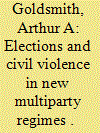

|
|
|
|
|
| Summary/Abstract |
The introduction of multiparty competition around the world following the Cold War raises the specter of rising civil violence during election periods in emerging democracies and hybrid regimes. Yet there are also plausible theoretical reasons to expect dropping civil violence around elections in these states or, alternatively, no significant change in the level of such conflict. This article tests these hypotheses in Africa with the aid of event data on the daily rate of civil violence incidents (1997–2013). It asks if civil violence in that region is more frequent, less frequent or constant during election cycles compared to other times. To guard against definitional and data selection problems encountered in some prior cross-national studies of elections and use of force, the research design emphasizes the relative risk of social conflict at the national level. The analysis suggests three distinct patterns in Africa. Given countrywide norms, election periods in most countries run the same relative risk of a day with violent events as do non-election periods. A subset of African countries exists, however, with more civil violence during elections when judged against the national reference line for conflict. There is a smaller group of countries where the risk of electoral civil violence is comparatively low. While caution should be exercised in interpreting the findings, the policy implication is that no general reason exists to preclude or defer elections in Africa as a way to minimize social conflict associated with political campaigns, although there may be specific reasons to do so in particular countries.
|
|
|
|
|
|
|
|
|
|
|
|
|
|
|
|
| 3 |
ID:
141228
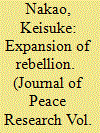

|
|
|
|
|
| Summary/Abstract |
Why do some rebellions expand gradually as rebel groups challenge in sequence, whereas other rebellions explode instantaneously as rebel groups challenge in unison? To address this question, we develop a dynamic and spatial model of rebellion that illustrates patterns of war fought between a hegemon (government) and its challengers (rebel groups). Our model incorporates three features into the standard coordination game: (a) potential rebel groups (players) are uncertain about the government’s strength; (b) battle outcomes are unpredictable; (c) these groups can be heterogeneous in terms of resolve and strength. In contrast to what existing theories commonly presume, our theory suggests that the sequence and timing of challenges are determined endogenously, depending on rebel groups’ resolve and strength. Through equilibrium analyses, we demonstrate that while simultaneous challenges are likely when rebel groups are relatively homogeneous, sequential challenges may emerge when one group is outstanding in terms of resolve and strength. Once this group rebels, other groups are inclined to ‘bandwagon’ as battles evolve, because the government is gradually revealed to be weak and because accumulated challenges shift the balance of power away from the government. Our theory also addresses why rebellious movements often spread across the periphery and can eventually reach the heartland as if a siege tightens. With an eye to historical incidents, we delineate four patterns of rebellion: (i) snowballing rebellion, which gradually escalates as more challengers are drawn in (Napoleonic Wars); (ii) catalytic rebellion, in which an instigator provokes a galvanizing event to inspire others to challenge the government (Boshin War); (iii) partially coordinated rebellion, which is initiated by a subset of ex post rebel groups (American Civil War, Yugoslav Wars); (iv) fully coordinated rebellion, in which all the rebel groups challenge collectively (American Revolution, Glorious Revolution).
|
|
|
|
|
|
|
|
|
|
|
|
|
|
|
|
| 4 |
ID:
141234
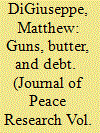

|
|
|
|
|
| Summary/Abstract |
I argue that favorable access to sovereign credit provides governments with greater autonomy to invest in security by allowing political incumbents to relax fixed-budget constraints. Borrowing permits leaders to delay and minimize the macroeconomic and redistributive costs associated with domestic sources of finance. Consequently, leaders of creditworthy states face fewer political costs when increasing military expenditure in response to growing demand or maintaining military expenditure when government revenues fall. A cross-sectional time-series analysis supports two observable implications of the argument. First, creditworthiness is positively associated with military spending with an effect on par with regime type. Second, creditworthiness conditions the effect of external threats on military expenditure, suggesting that poor credit terms constrain the provision of security.
|
|
|
|
|
|
|
|
|
|
|
|
|
|
|
|
| 5 |
ID:
141230
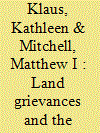

|
|
|
|
|
| Summary/Abstract |
Recent studies have asked why elites resort to violence, yet many overlook the process and dynamics of mobilizing violence. How do politicians convince their supporters to fight? This article argues that in multi-ethnic and democratizing societies where land and property rights are weak and politicized, land grievances can provide leaders with a powerful tool to organize electoral violence. We develop a theory to show how land grievances can give rise to violent mobilization when leaders frame elections as a threat to the land security of supporters or an opportunity to reclaim land or strengthen land rights. Conversely, land grievances are ineffective when citizens do not believe that elections signal a credible threat to their land security or an opportunity to strengthen land rights. We further specify how the type of land grievance shapes the logic and form of violent action. Grievances based on land insecurity shape a pre-emptive logic of violence, while grievances based on competing land claims often shape an opportunistic logic of electoral violence. The article examines the validity of our theory using a comparative case study between zones of escalation and non-escalation of violence during post-electoral crises in Kenya (2007–08) and Côte d’Ivoire (2010–11). By observing the variation between positive and negative cases, the article identifies factors that foment and constrain the mobilization of election violence.
|
|
|
|
|
|
|
|
|
|
|
|
|
|
|
|
| 6 |
ID:
141232
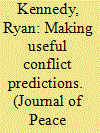

|
|
|
|
|
| Summary/Abstract |
One of the major issues in predicting state failure is the relatively rare occurrence of event onset. This class skew problem can cause difficulties in both estimating a model and selecting a decision boundary. Since the publication of King & Zeng’s studies in 2001, scholars have utilized case-control methods to address this issue. This article builds on the landmark research of the Political Instability Task Force comparing the case-control approach to several other methods from the machine learning field and some original to this study. Case-control methods have several practical disadvantages and show no measurable advantages in prediction. The article also introduces cost-sensitive methods for determining a decision boundary. This explication raises questions about the Task Force’s formulation of a decision boundary and suggests methods for making useful predictions for policy. I find that the decision boundary chosen by the PITF implicitly assumes that the cost of intervention is about 7.7% of the cost of non-intervention when state failure will take place. These findings demonstrate that there is still much work to be done in predicting state failure, especially in limiting the number of false positives. More generally, it suggests caution in using accuracy as a measure of success when significant class imbalance exists in the data.
|
|
|
|
|
|
|
|
|
|
|
|
|
|
|
|
| 7 |
ID:
141231
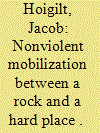

|
|
|
|
|
| Summary/Abstract |
Recent research on contentious politics in the Middle East emphasizes the importance of repression and its effect on social movements, often manifested in demobilization and so-called ‘nonmovements’. This case study of West Bank Palestinian activism seeks to go beyond such outcomes. The current, youthful nonviolent Palestinian grassroots activism in the West Bank is persistent, despite repeated violent repression. Focusing on the interplay between context, practices, and networks, this article shows how an increasingly vocal and visible popular resistance movement has asserted itself despite facing double repression – from the occupying Israeli state and the Palestinian National Authority. In a highly repressive context characterized by widespread demobilization, especially among young people, the impetus for mobilization is not perceived opportunity, but rather existential threats. The analysis focuses on how long-term repression from the external occupier and the internal elite contributes to forming specific kinds of contentious practices and networks among young Palestinian grassroots activists. By deploying new and creative contentious tactics they partly succeed in challenging the Israeli occupation without risking sanctions from the internal Palestinian elite. They are also able to criticize this elite implicitly, bringing popular pressure to bear on it. However, while the strategic use of nonviolence has provided these activist environments with a degree of resilience in the face of repression, they are unable to mobilize on a wide scale as long as the Palestinian political elite does not support them.
|
|
|
|
|
|
|
|
|
|
|
|
|
|
|
|
| 8 |
ID:
141227
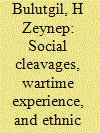

|
|
|
|
|
| Summary/Abstract |
What explains ethnic cleansing? Recent research has used systematic evidence to explore the causes of civilian victimization and mass killings. Yet, comparable studies that focus on ethnic cleansing are still rare. This article conceptualizes ethnic cleansing as a group-level phenomenon that is distinct from civilian victimization or mass killings and studies its causes by using systematic evidence from Europe 1900–2000. The article makes two theoretical moves. First, it highlights the salience of non-ethnic cleavages such as social class as a background condition that has the ability to hinder ethnic cleansing. Second, it distinguishes between two causal mechanisms, one that considers wars as ‘strategic environments’ and the other as ‘transformative experiences’, that relate to the proximate causes of ethnic cleansing. Using original data from 20th-century Europe, the empirical analysis offers two main findings. First, it shows that salient social cleavages, measured through levels of land inequality, political competition, and support for left-wing parties, substantially decrease the risk of ethnic cleansing. Second, the analysis suggests that the arguments that underscore psychological mechanisms related to wartime experiences provide a better explanation for ethnic cleansing than the arguments that emphasize the role of strategic wartime aims. This finding is further supported by a brief discussion of key cases in which both causal mechanisms predict ethnic cleansing. The results highlight the importance of treating ethnic cleansing as a conceptually separate phenomenon and offer implications for the debate on democracy and mass ethnic violence.
|
|
|
|
|
|
|
|
|
|
|
|
|
|
|
|
| 9 |
ID:
141226


|
|
|
|
|
| Summary/Abstract |
To date, little attention has been paid to the question of how episodes of mass killing are terminated. This has allowed several misconceptions, such as the notion that external armed intervention is a principal form of ending, to arise and profit. This study presents preliminary findings from a survey of cases of state perpetrated mass killing since 1945. It examines the forms of ending, finding that around half end only when the perpetrators themselves decide to end the killing, usually because they have accomplished their goals. It also explores the relationships between modes of termination and lethality and the resilience of different types of ending and offers insights into the implications for policy of some of these findings. It argues that foreign armed intervention is extremely rare and does not deserve, therefore, to be the common ‘go to’ option of advocates and analysts. Instead, presuming that armed intervention is off the table, it is more important to think in terms of what can be done to shape the perpetrators’ incentive structures or encourage internal dissent within the perpetrating elite. Finally, it shows that there is no easy overlap between what is morally palatable and what saves lives. Arming rebels may be morally pleasing, but may lead to protracted civil wars with atrocities – the worst of all outcomes. Likewise, negotiating to secure the state perpetrators’ core interests may feel immoral but might stop the killing and save lives.
|
|
|
|
|
|
|
|
|
|
|
|
|
|
|
|
|
|
|
|
|